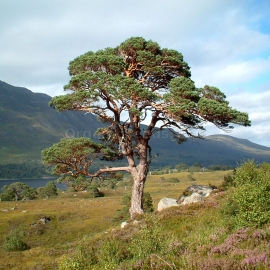






Organic Scots Pine Seeds (Pinus Sylvestris L.)
1.14 €
The Scots pine, also known as the common pine or red fir is one of the most important tree species in Europe both economically and ecologically. Its range covers all of Eurasia and stretches from the Arctic Circle in the north to the south of Turkey.
-
Organic Scots Pine (Pinus Sylvestris L.)
The Scots pine, also known as the common pine or red fir is one of the most important tree species in Europe both economically and ecologically.
Its range covers all of Eurasia and stretches from the Arctic Circle in the north to the south of Turkey and from the West of Europe to Asia in the East. There are also isolated natural populations in Scotland and the Pyrenees.
The Scots pine belongs to the 2 needle pines. The pairs of needles remain on the tree for 3-4 years and reach a length of 2.5 to 7 cm. Their colour ranges from yellow/green to blue/green depending on location. Scots Pine trees are tall growing and can reach 35 m. or even 40m if growing in good locations.
The bark has a characteristic reddish- brown colour which is also known as mirroring bark, as it sometimes reflects sunlight. Pine trees can reach an age of 800 to 1000 years.
The wood which is rich in resin has a warm yellow to light red colouring. It is an excellent and much prized construction timber for use in both interior and exterior construction (windows, doors, floorboards, furniture construction). Pine wood has minimal warping and is very durable.
Extracts from pine needles are traditionally used in medicines for colds and the treatment of aching muscles. Sauna fragrances, bath or massage oils. The trunks of larger tree can be tapped for resin secreted resin which can be used in varnish, glue, pharmaceutical and cosmetic articles
One of the Britain's few native conifer species, a tough and adaptable tree capable of steady growth on many different soil types and climatic zones. It thrives on mineral soil and sand low in nutrients and grows well on almost any soil type except chalk. Natural regeneration occurs freely in suitable conditions on sandy soils with an absence of grazing pressure.
How to Grow
Scots Pine also makes an ideal candidate for creating a bonsai specimens and for Christmas tree growing. It is a very easy tree to germinate and grow making it an ideal species for inexperienced growers.
Scots Pine seeds are relatively easy to germinate and grow. The dormancy within the seed is short and easily broken and reasonable success can be expected even when seeds are sown without any form of pre-treatment. The benefit of a short period of pre-treatment is that a greater percentage of seeds will germinate and the germination of the seedlings will be syncronised with most seedlings germinating within a few days of each other.
The pre-treatment is done as follows. Soak the seeds in water for 24 hours. Fully drain away all of the water and place the seeds in a zip-lock freezer bag. Place the seeds in the fridge, it is important that during this period that the seeds do not dry out or are waterlogged otherwise the pre-treatment will be ineffective.
It is important to keep checking the seeds every week or so to make sure that they are not drying out. You could also at the start of treatment incorporate a little damp vermiculite or perlite, this helps to keep the seeds moist but not waterlogged.
After around 4 weeks under these conditions the seeds are ready to be sown. Seeds should be sown into containers filled with a good quality general potting compost. Suitable containers could be plant pots, seed trays or plug trays or even improvised containers with drainage holes. Firm the compost gently and sow the seeds on the surface. If you are sowing in plug trays, sow 1 or 2 seeds per cell.
Cover the seeds with a couple of millimeters of vermiculite or failing that a fine layer of sieved compost. Follow with a gentle watering and keep them at room temperature. Germination will begin within a 10-14 days of sowing.
The seedlings are reasonably robust and trouble free and usually grow to a height of between 3 and 10 cm in the first growing season depending on the sowing date and cultural techniques.
Developing seedlings should be fine in full sun, keep them well watered and free of competing weeds.
Growth will accelerate in the second and subsequent years and the developing young trees should be re-potted as necessary preferably during the dormant season. After perhaps 2 or 3 years they are ready to be planted in their permanent position
This species will grow very large, very rapidly so plant it well away from buildings, power lines, etc.
